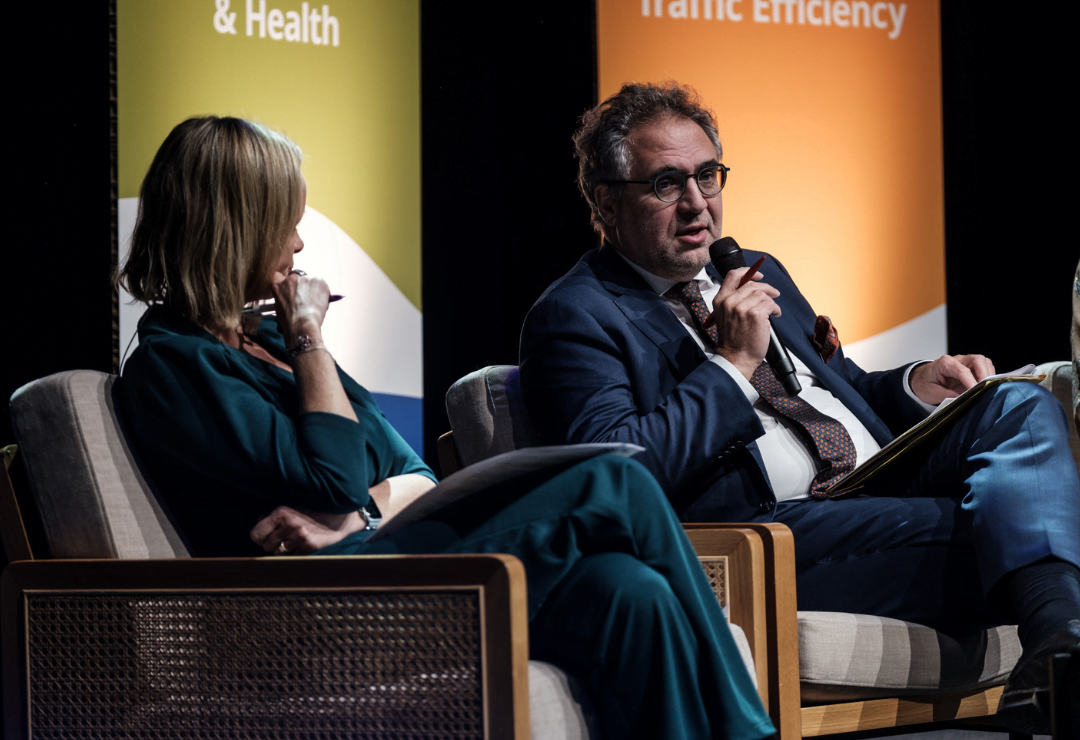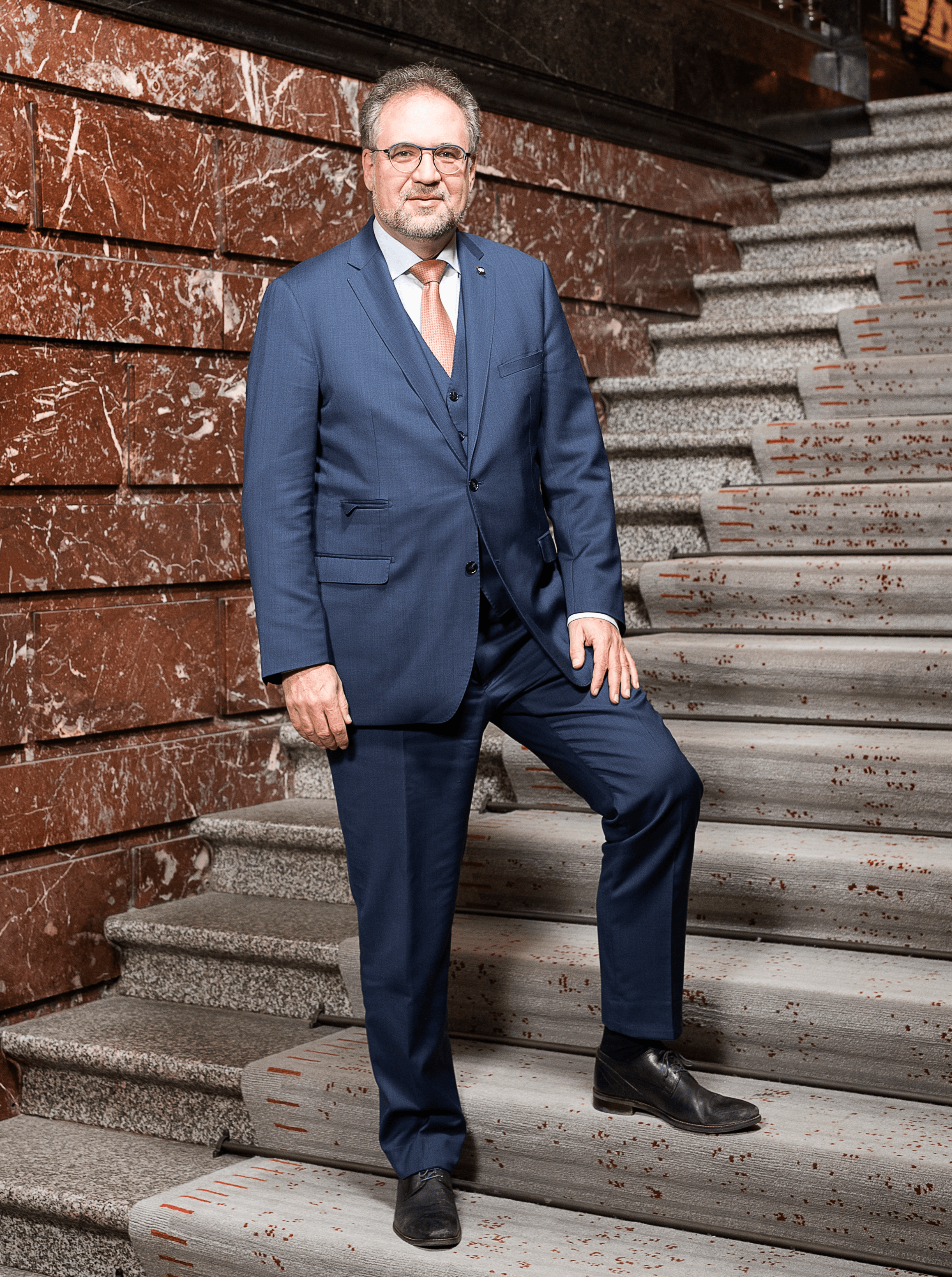Antwerp's Advance
POLIS speaks to Koen Kennis, Vice Mayor of Antwerp and panellist for the Opening Plenary of our 2023 Annual Conference, about the future of sustainable mobility, and how a city renowned for being a logistics and tourist hotspot is doubling down in sustainable transit.
An interview with Koen Kennis, elaborated by Isobel Duxfield and Karen Vancluysen.
To listen to the recording of the article below, please accept all cookies.
POLIS: What are Antwerp’s key goals when it comes to urban mobility?
Koen Kennis: Our main goal is to reach and maintain a modal shift, while at the same time keeping the city liveable, (and reachable) for all transport modes and in balance with its role as the economic powerhouse of Flanders and Belgium.
Koen Kennis, Vice Mayor, City of Antwerp. Credit: Philippe Verhoeven
POLIS: What do you see as the key mobility challenges in Antwerp?
Kennis: Currently, the city is undertaking massive infrastructural works (the ‘Big Link’). This is necessary for us to finally close the Antwerp ringway and make the city more liveable. These works will be finished in 2030 and include building a new crossing under the river Scheldt and more tunnelling underneath the docks. The ringway will be covered as much as possible, making way for extra green spaces.
The city and its roads will change immensely. The key challenge is to keep the city reachable during these works which will last for several years.
POLIS: Antwerp is a forerunner when it comes to cooperating with shared mobility service providers from the private sector. How do you regulate as well as incentivize them and what is the role of the marketplace you have created?
Kennis: Shared mobility providers who wish to operate in Antwerp have to meet the conditions set out in our regulatory framework, containing a set of rules and standards (for example the specific number of vehicles per area permitted, and sharing of real-time and user data). By doing so we manage to avoid shared mobility interrupting or damaging mobility for the general public.
Furthermore, we make sure that their services are in line with the city’s mobility policy. If operators do not respect the rules, we can limit the scope of their operations. Avoiding problems is the best way to create the necessary common ground between users and non-users.
The marketplace for mobility does not focus on shared mobility specifically but has a broader view. It aspires to activate all mobility players and even entrepreneurs and institutions alike, trigger them to come up with solutions for existing challenges, and work together, thus creating a viable mobility ecosystem in Antwerp.
POLIS: Antwerp is a major freight centre with the second largest port in Europe. In what ways have you been able to “clean up” logistics in the city? And what learnings may this have for other cities facing similar challenges?
Kennis: ‘Cleaning up’ logistics has been an ongoing process in Antwerp for many years now. Through piloting together with the sector, an ongoing dialogue with stakeholders and project call launches, we have been able to gain many useful insights throughout the years.
As a city, we have learned that it is important to have stakeholder support for city decisions, that testing on the field is of key importance, that freight is and will always be necessary for the city, that sustainable logistics also involves traffic safety, that connecting with other cities is of great value.
The city has had pilots on water-bound logistics, construction logistics, freight route planning, consolidation, and more.
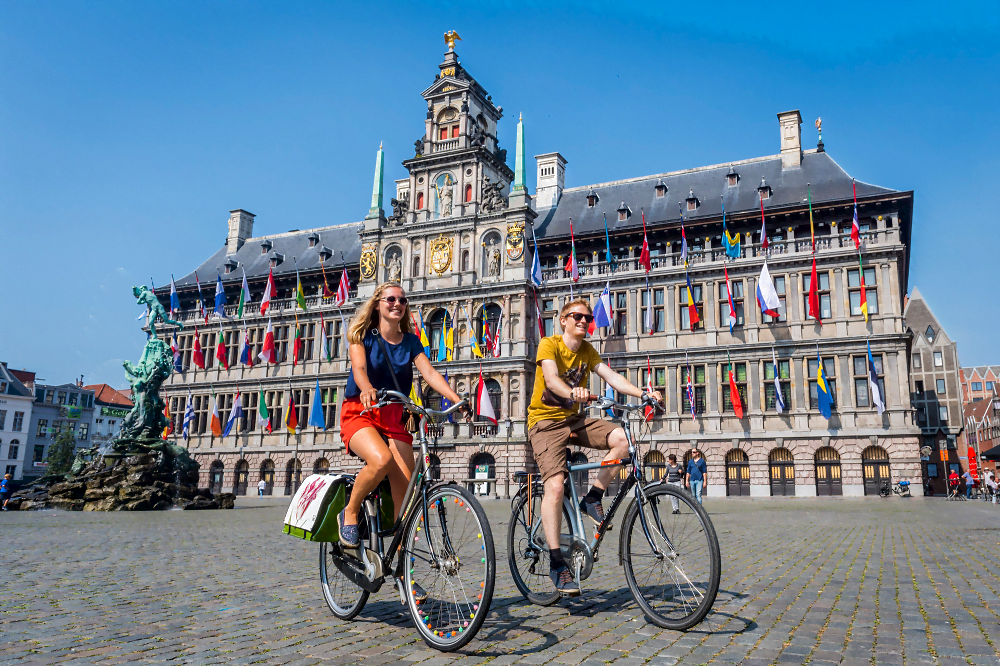
Cycling Grote Markt, Antwerp. Credit: Frederik Beyens
In addition to these pilots, the city participated in many regional and European projects to learn even more. Last year, the city initiated the writing of a SULP (Sustainable Urban Logistics Plan), on data analysis and stakeholder sessions with sector representatives. The SULP will be ready by the beginning of next year, starting a new chapter in ‘cleaning up’ logistics in the city.
In perhaps a more literal sense of ‘cleaning up’, the city has been selected as a research city in a study initiated by the Flemish government on the introduction of zero-emission logistics in city centres.
POLIS: Antwerp also cooperates with surrounding regional authorities. In 2017 Antwerp reached an important milestone in its multimodal journey with the ‘Alliance for the future’, an agreement between different partners to offer better mobility options and improve life quality in the Antwerp region. What advice would you have to other municipalities for developing and sustaining such collaboration?
Kennis: Define a common goal and ensure it is shared by all relevant stakeholders. Set up the organisation accordingly to maximize societal added value. In Antwerp’s case, the common goal is the ambition to build a city that people enjoy living in, work and do business in, and visit.
Within the city administration, several task forces were set up to tackle social challenges, turn them into opportunities and provide internal coordination. On a government level, the ‘Alliance for the Future’ foresees a tailor-made governance structure to manage the project. It consists of three levels:
- First level: the Regional Council brings together Mayors of the entire region with delegates from the Provinces and the Flemish parliament to decide on substantive proposals and advise the minister in spending within a multi-annual budget.
- Second level: the Working Community closely follows up on the implementation of the Alliance for the Future and the translation to operational plans. The City of Antwerp and the civic movements are the main actors.
- Third level: the Working Platform brings together the major executive agencies, local government services, as well as the Belgian railways, the Flemish tram and bus company to provide for specific development and implementation of the various sub-projects.
The three bodies work closely together. The idea of this unique structure, with a structural role for civic movements, is to proactively prevent conflicts and work in a problem-solving manner in the coming years.
It provides a long-term collaborative framework to jointly deal with the unforeseen and unplanned, which is unavoidable given the scale and timespan of the project.
POLIS: Behind these harder measures and infrastructure developments, ‘mindset’ change is essential for achieving the significant modal shifts required. In fact, ‘Smart Ways to Antwerp’ focuses on soft measures like communication supporting behavioural change, and encouraging citizens to recognise and adopt different ways of travel. What have been the main successes of this initiative? And what else does it have planned going forward?
Kennis: A modal shift in the broad sense of the word is taking place in Antwerp. Our latest trend report (published in May 2023) clearly shows a shift away from the car in both professional and recreational mobility, across all age groups.
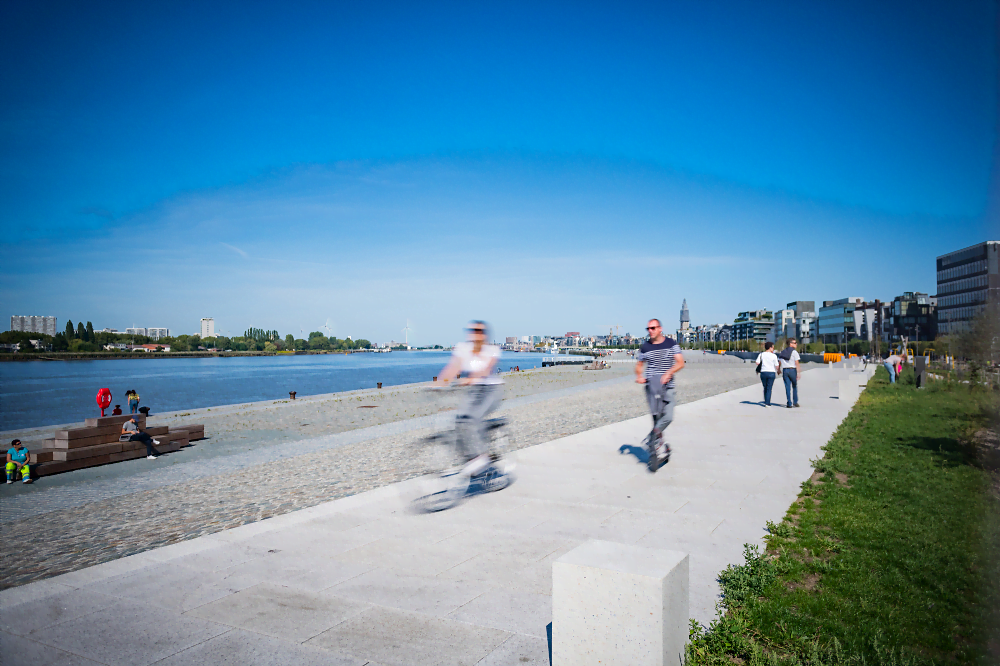
Cycling paths along the Scheldt in Antwerp. Credit: Gianni Camilleri
The statistics show that all the efforts of the city, including the programme of Smart Ways to Antwerp are paying off. The multimodal route planner with turn-by-turn navigation is truly unique and gives travellers personalized, smart advice. With the employers’ approach, we reach more than 150 employers in Antwerp, representing 71,000 employees.
The Marketplace for Mobility has 145 active partners. Smart Ways to Antwerp has grown into a high-quality source of information and a reliable partner in the mobility world.
POLIS: Active travel has played a growing role in Antwerp’s mobility mix. Indeed, the city has an impressive web of cycle networks within the city, as well as connecting it to peripheral areas, and in 2022, for the first time, more residents opted for the bicycle than the car for their daily commute to work (42.6% bike versus 36.2% car). What is the secret to success here? (push and pull measures etc, success of public bike-sharing scheme)
Kennis: Safe infrastructure is key, as is the underlying logic of the network. Since 2013, the city of Antwerp invested a lot in defining and getting rid of missing links, making cycling the best, most logical and most fun option to get around the city. Expanding the network outside of the city boundaries was the next step.
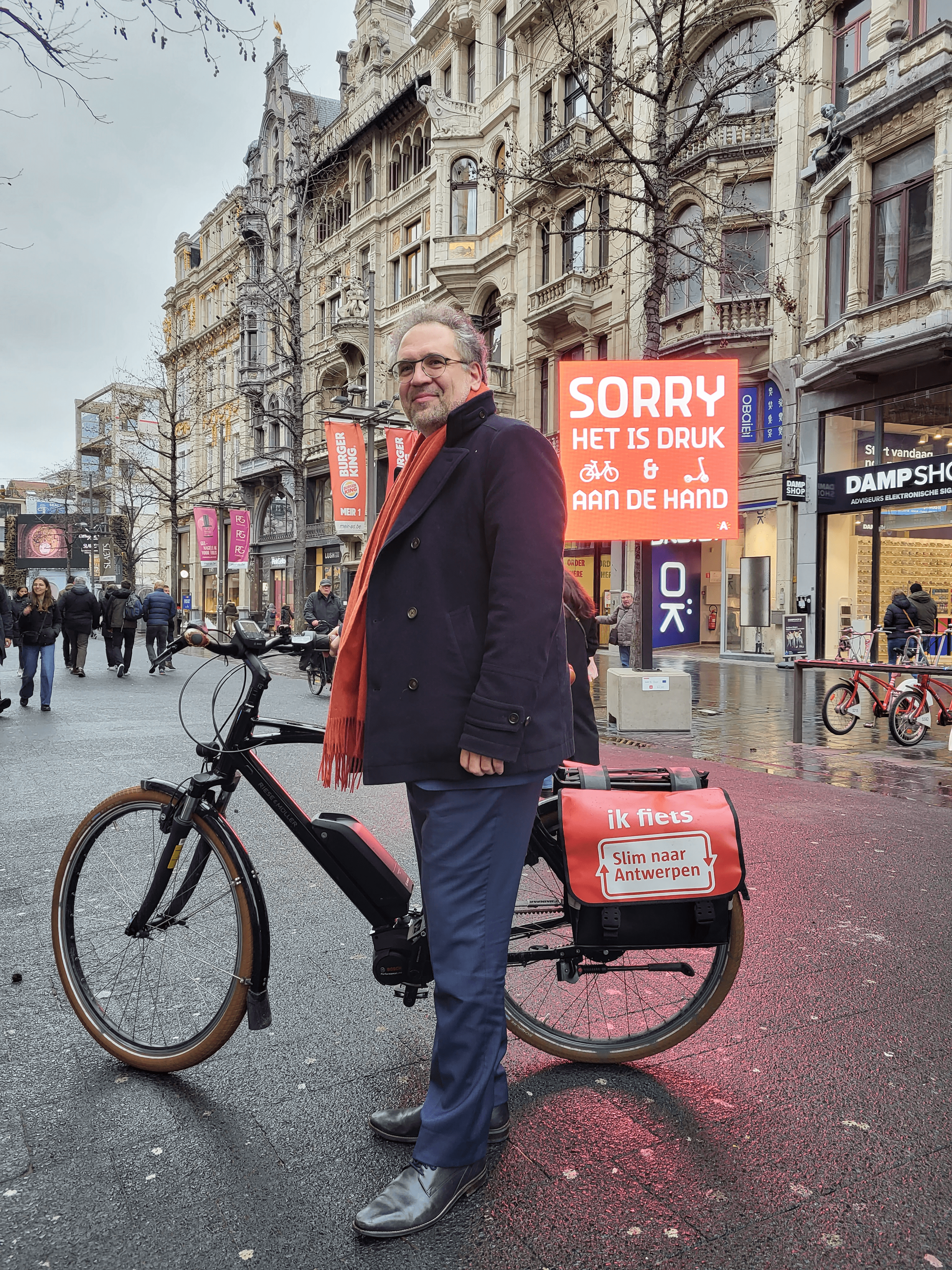
Koen Kennis in Antwerp. Credit: Dirk Vermeiren
In the Antwerp Transport Region, consisting of 32 municipalities (1.1 million inhabitants) a network of 2,000+ shared e-bikes was installed, even expanding into neighbouring regions. To make the city attractive for pedestrians the historical city centre is turned into residential areas, and streets are refurbished for less, slow and local traffic. The use of shared mobility and public transport is also actively encouraged.
The integrated approach and the combination of a wide range of measures is what has led to these successful results.
POLIS: At the same time, road safety and protecting cyclists and pedestrians remains a key point to work on in many cities. How does Antwerp tackle this ongoing challenge?
Kennis: Safety comes first. As stated, optimizing our network in terms of safety and comfort is crucial. Updating existing bike lanes very often means broadening them, and building new bike lanes is done according to the recent standards. Accidents are intensively studied based on police reports and if needed urgent action is taken. Wherever possible traffic modes are separated physically in different lanes. Where not, appropriate measures are taken. This an ongoing process, aiming to improve our infrastructure for all transport modes.
POLIS: This year Antwerp joined POLIS, becoming one of many Belgian cities in the membership. How do you hope to use the membership to learn from others, and share your own experiences?
Kennis: Collaboration with POLIS matches with the ambition of Antwerp to be a leading European city in innovative, sustainable and smart mobility. With the recognition that the city has acquired in recent years through participation in various European projects (SCALE-UP, SPINE, PIONEERS, MOBI-MIX, FAST TRACK, LEAD) we can share experiences within the POLIS network, learn from other cities and address common issues on EU level.
POLIS: Antwerp has also been selected by the European Commission as one of the 100 Climate-Neutral and Smart cities. From that perspective, what do you expect Antwerp’s mobility landscape will look like by 2030?
Kennis: A modal shift toward sustainable modes of transport for the city and the region. A fully completed Antwerp ring road, partly covered, with lots of new extra space for people walking and cycling. And more capacity for all transport modes to cross the river Scheldt, including a first bridge over the river (pedestrians and cyclists only).
Click here to read the article in its original format.
About the contributors:
Interviewee: Koen Kennis the Vice Mayor of the City of Antwerp, responsible for mobility, tourism, finances, retail, and decentralisation. He also serves as the Chairman of the Antwerp Transport Region.
Interviewer: Isobel Duxfield previously worked as Communications and Membership Manager at POLIS and led the SMC Platform and Regions Working Group. She completed her MPhil in Gender Studies at the University of Cambridge, where she researched gender and cycling. She managed the SUM4All project and has published academic work on gender, active mobility, and domestic violence prevention.
Interviewer: Karen Vancluysen was appointed as Secretary General of POLIS in September 2014, after having been the network's Research Director for 8 years. Since 1998, she has been involved in urban mobility networking, innovation, and policy activities as well as a wide range of European urban transport research projects.
